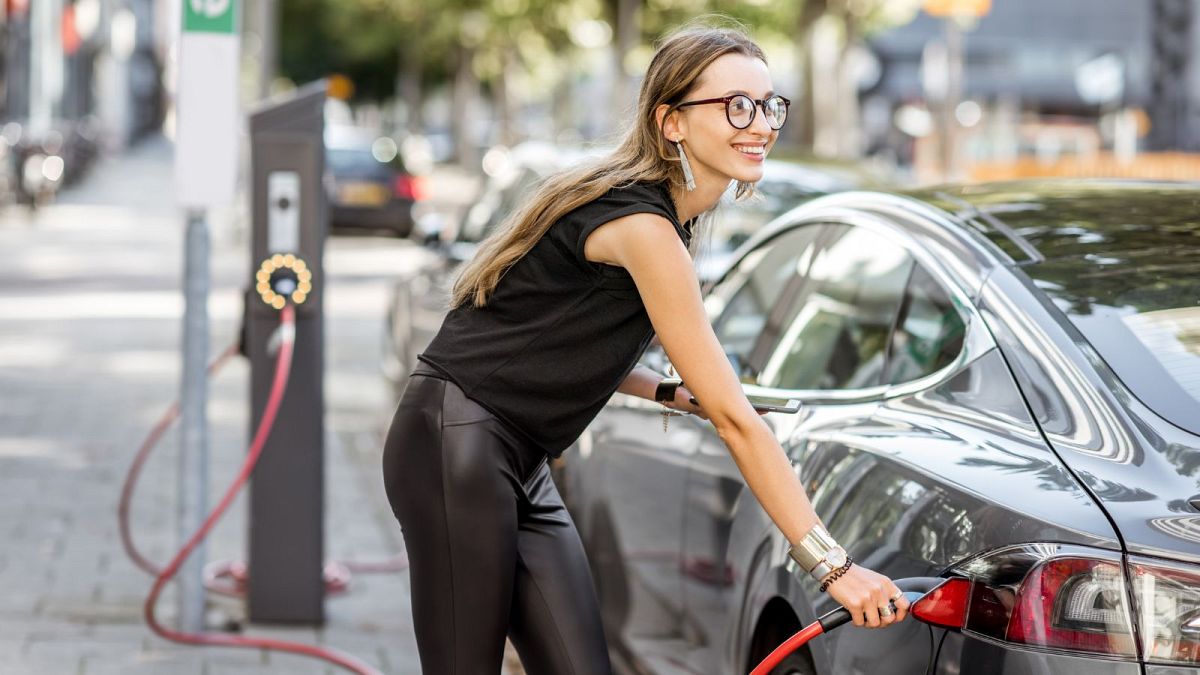Germany has more than a million battery-powered cars, but another nation is doing the best on EV penetration - here’s why.
Electric cars aren’t the answer to the climate crisis. But they’re a significant part of the energy transition towards zero emissions.
Fortunately, battery-only vehicles are becoming increasingly popular. In 2022, the number of these fully electric passenger cars in EU countries increased by 58 per cent compared to 2021 - from 1.9 million to 3.1 million. Between 2019 and 2022 they soared by more than 400 per cent.
More significantly, the share of EVs among the total number of cars rose to 76 per 10,000 in the EU in 2021, up from only 2 per 10,000 in 2013. All these figures show a timely sea change in the automotive sector in Europe.
Passenger cars are responsible for about 12 per cent of total EU emissions of carbon dioxide.
In February, the European Parliament voted to approve a new law banning the sale of petrol and diesel cars from 2035. This law now awaits a final vote by the European Council, which was postponed as it was believed it wouldn't receive the required majority.
As EU lawmakers seek to speed up the switch to electric vehicles, we’ve taken a look at which countries are leading the way. Which European nations are moving fastest away from fossil fuel-powered vehicles? And which have the highest share of electric makes among all cars?
In 2013, there were only 52,000 fully electric cars in the EU according to Eurostat. This figure rose gradually at first, reaching 600,000 in 2019, and the number of fully electric cars has boomed every year since then. It exceeded 3 million in 2022.
These figures reflect the total number of fully electric cars, not the newly registered ones each year. The 2022 data come from the European Automobile Manufacturers’ Association (ACEA).
The share of fully electric cars among the total number of cars is a more meaningful statistic. In 2013, it was only 2 per 10,000 cars. The number per 10,000 rose to 24 in 2019, 44 in 2020 and 76 in 2021. While their share is still limited for now, the rate of increase over the last decade suggests huge growth in the near future.
Number of fully electric cars exceeds a million in Germany
In 2022, the number of fully electric cars exceeded 500,000 in four European countries; namely Germany (1,089,854), the UK (641,801), France (605,791) and Norway (603,697).
They were followed by the Netherlands (318,485), Sweden (205,212) and Italy (167,213).
The Eurostat figures, which go up to 2021, have been combined with the ACEA’s 2022 figures for a full picture of the state of electric cars in Europe.
Norway is racing ahead with its share of fully electric cars
More so than the numbers, the shares of fully electric passenger cars among all passenger cars demonstrate how well different countries are doing in moving away from fossil fuel energy. As of 2021, Norway has done the best by far in its progress towards zero emissions.
In that year in Norway, 15.5 per cent of all cars were fully electric. This rate was just 0.8 per cent in the EU as a whole.
The Netherlands (2.8 per cent), Denmark (2.4 per cent), Sweden (2.2 per cent) and Iceland (2.2 per cent) also had a higher than 2 per cent share of fully electric cars in 2021.
The share of fully electric cars among all cars was 1.3 per cent in Germany, 1.2 per cent in the UK and 1 per cent in France.
Cyprus, Poland, Bulgaria and Czechia (all 0.1 per cent) had the lowest shares of battery-only electric cars in the EU.
How many new cars were electric last year?
The share of fully electric passenger cars among newly registered cars is another significant indicator showing how well countries are progressing towards zero emissions. In the EU, 8.3 per cent of all newly registered cars were fully electric in 2021. This increased to 12.1 per cent in 2022: a 45 per cent increase in just a year.
4 of 5 cars sold in Norway in 2022 were fully electric
In 2022, Norway was again an outlier with its share of fully electric cars among all newly registered cars being 4 out of 5 (79 per cent).
It was followed by neighbouring Sweden (33 per cent), then Iceland (31 per cent), the Netherlands (24 per cent) and Denmark (21 per cent). This figure was 18 per cent in Finland, indicating that Scandinavian countries are doing the best in moving away from fossil fuel energy.
These were also the countries that had significantly increased shares of fully electric cars between 2021 and 2022.
In the same year, Slovakia and Czechia (both 2 per cent) had the lowest shares of fully electric cars among newly registered cars.
This rate was 18 per cent in Germany, 17 per cent in the UK and 13 per cent in France.
Germany leads in newly registered fully electric cars
In 2022, over 350,000 fully electric cars were registered in Germany, which was the highest number by far according to ACEA data. The UK (190,727), France (162,167) and Norway (113,751) followed Germany.
This figure was lower than 1,000 in Cyprus, Latvia, Bulgaria and Estonia.
How do plug-in hybrid electric cars compare?
Some European countries also have high numbers of plug-in hybrid electric passenger cars, which have been a mainstream option for over a decade. They combine petrol tanks with electric batteries, and so need recharging from an external power source.
In 2021, Germany had over 565,000 plug-in hybrid electric passenger cars, followed by the UK (over 315,000), France (almost 300,000) and the Netherlands (over 140,000).
The share of plug-in hybrid electric cars among all cars in 2021 was highest in Norway, where 5.9 per cent of all cars were plug-in hybrid electric.
Why does Norway have the highest share of electric cars?
In Europe, the most successful country in switching to electric vehicles is clearly Norway; in fact, this oil-rich country is a statistical outlier. Why does Norway have the highest share of electric cars?
Its “carrot-and-stick approach” is the key according to Yoann Le Petit, a Clean Vehicles Officer at Transport & Environment.
Norway has pushed manufacturers towards electric vehicles by imposing strict pollution limits and insisting all new cars sold by 2025 must be emission-free. This is the “stick” of the policy.
According to the Organisation for Economic Co-operation and Development (OECD), Norway’s carrot comes in the form of subsidies.
Motorists are being offered generous tax incentives, including the exemption of zero-emission vehicles (ZEVs) from the registration tax, VAT and motor fuel taxes, as well as at least a 50 per cent reduction in road taxes and ferry and parking fees.
Almost one-fifth of cars will be electric in 2023
The overall share of battery-only electric passenger cars is expected to grow considerably in the years leading up to the 2035 EU ban on combustion engine cars according to Eurostat.
This planned ban is linked to the Sustainable Development Indicator that involves reducing CO2 emissions from new passenger cars.
Globally, the IEA’s annual report predicts that sales of electric cars are set to surge to record heights again this year, expanding their share of the overall car market to close to one-fifth.
More than 10 million electric cars were sold worldwide in 2022 and sales are expected to grow by another 35 per cent this year to reach 14 million according to the IEA.
This explosive growth means electric cars’ share of the overall car market rose from about 4 per cent in 2020 to 14 per cent in 2022 and is set to increase further to 18 per cent this year, based on the latest IEA projections.



